
Back in the year 1950, Vittorio Minarelli and Franco Morini formed a partnership to set up FBM (Fabricca Bolognese Motocicli), and establish a factory manufacturing motor cycle and moped engines. Franco Morini was the nephew of the Alfonso Morini who is more familiarly known as the founder of Moto Morini motor cycles in Bologna.
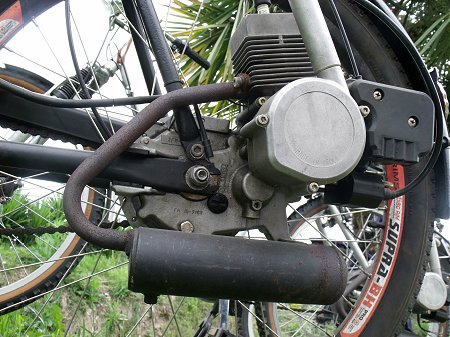
FBM's first products were complete motor cycles up to 200cc but, in 1954, the business began further manufacture of moped engines in addition to building motor cycles. The partnership soon began to disintegrate as Franco Morini set about establishing his own company under the name of "Morini Franco Motori" at Zola Predosa, Bologna and, in 1956, FBM motor cycle production ended as the partners formally split.
Vittorio Minarelli re-established his business as "F.B.Minarelli" in Bologna, with the result that there were now two independent factories producing very similar 50cc moped motors ... so similar in fact, that some parts could even be interchanged between the two different makes. Morini Franco Motori did make light motor cycles and mopeds for a short period, but the brand was mainly only sold into the Italian domestic market, and the company subsequently concentrated on manufacture and supply of proprietary engines to other manufacturers.
In April 1999, Morini Franco Motori SpA negotiated manufacturing rights to use the Moto Morini badge, returning the name to within the Morini family, and established a factory producing new Moto Morini motor cycles next door to its existing proprietary engine plant at Casalecchio di Reno.
It's pretty much established that the cyclemotor gold rush years were in the late 1940s & early 1950s, but Morini Franco Motori seems to have introduced their FM128 model cyclemotor unit slightly after the gold rush ... rather, quite a long time after the gold rush ... err, around 1996 actually! So what on earth might inspire a manufacturer to produce a 28cc cycle-motor wheel around 45 years after the main event? No, we don't know the answer to that either, but do drop us a line if you have anything to add.
Anyway, while producing our special New Zealand based issue, we thought we'd have a look at a few of these machines along the way, since there happens to be a selection of examples available here on the far side of the world.
First batch models came into New Zealand around 2006, brought into the country by Silver Fern Importers, who were more generally known as KTM motor cycle distributors. The first batch of mountain bike cycles were characterised by their hard tail rear frame, compression sprung forks, and 24×1.25 tyre & wheel size.

Our first batch example is painted silver, and that is thought to have been the only colour for this first lot of machines. Since the cycle frames are a fairly typical market produced nameless item, these are of little interest to us other than for reference - our main interest being in the fitted rear wheel, since this contains a Franco Morini FM128 cyclemotor. Specifications rate the two-stroke engine as producing 1.1bhp (0.8Kw) @ 6,000rpm from a given compression ratio of 7.5:1. The 32mm bore × 35mm stroke gives a capacity of 28.1cc, with reed valve intake induction direct into the crankcase and supplied from a Dell'orto SHA12/7 carburettor (7mm venturi). Sparks are provided by an Italian IDM electronic ignition flywheel magneto set with no lighting generation capability. The bikes came complete with a fully fitted rear fuel tank/carrier and lubrication given as petroil pre-mixture at 50:1 proportion, though a pumped-oil option is quoted among the specifications.
The motor arrangement sets the engine just behind the axle with a forward drive case providing transmission to the hub through an automatic centrifugal clutch that runs in the gear drive oil bath. The exhaust pipe runs forward and outboard of the cycle frame to the silencer below, allowing the complete motor wheel to be fairly easily removable for servicing of the rear tyre.
Some early first batch motors came equipped with a band brake acting on an integral hub ring within the drive case, though a number of the bike frames seemed to utilise the fitted rear cycle brake instead, preferring to just leave the band-brake mechanism in place, unconnected. Later batch engines seemed to have omitted fitting the band-brake plate completely.
While the 'pro' specification suggests the motor should be adequately up to its task, unfortunately, the bikes came with a number of 'cons'...
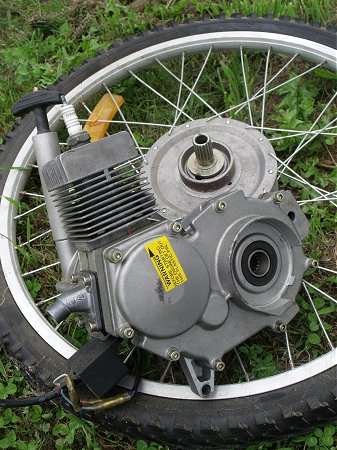
The performance of these machines can be as variable as their quality, and different operational problems may be related to both the engine manufacturer and installation assembly within the cycle frames. Some motors have reportedly suffered from premature piston/ring failure, which has invariably proved quite disastrous to the engine, but by far the greatest problems came with generic faults of rear wheel spacing/axle/bearing issues as a result of poor adaptation and installation to the mountain bike frames.
It appears that Morini supplied the motors as a base kit complete with the cast hub halves, then poor design, specification and lack of testing by the unknown assemblers. Mild steel axle and bearing spacing arrangements meant that most of the driving wheels would be doomed to seize within a very short period of operation. Presumably, as the problems became apparent, the first importer cheaply unloaded the remaining bikes, spare engines, and all back-up parts, to distance themselves as quickly as possible from the troubles.
The only resolution to most issues with the bikes & motors subsequently came down to any owners to resolve themselves by re-engineering the axle arrangement.
Our 'first batch' test bike (silver) appears to be one of the luckier ones, seemingly having survived a moderate amount of usage on the original axle/bearing arrangement, though now seems to suffer a certain variable slackness and binding in rotation of the wheel, and produces a number of worrying mechanical complaints from its bearings, so appears refurbishment may be imminent.
We're not particularly enthralled at the prospect of riding the machine in this mechanical condition, but haven't gone to the trouble of travelling 13,000 miles to bottle out over some dodgy bearings, so summon the bravado to bite the bullet and take a 'brief-as-possible' test run along the road to at least gain some impression.
We're told the motor always wants to be rich for starting, so catch on the choke lever between the carburettor and airbox case, and in normal Dell'orto fashion the latch will be released when the throttle is opened full. The filter cases are reported to be 'limited by restricted induction ports', so it seems to have become standard practice to drill these out to a larger size and allow the engine to 'breathe a little easier'.
Turn on the fuel tap under the tank, and pull the recoil handle to turn the engine. It's rather like trying to start a garden strimmer, keep pulling the recoil and the motor spins over with absolutely no sign of life, then suddenly fires up and has to sit there on tick-over for ages while the engine slowly creeps up to temperature, before you even dare try a bit of throttle. Too early, and the engine dies right out, so you have to be patient.
The throttle is controlled by a small trigger on the right hand bar, and when the motor is finally warm enough to play, you can flick the trigger to release the choke and we're ready to ride.
Throttle response is eager and snappy. Without a rider mounted, the automatic clutch readily bites at a twitch of the trigger, and you can feel the little motor is dead keen and raring to go.
The Morini hub is only mounted with a standard cycle freewheel, so there's no selection of gears to assist the engine much but, as it happens, the motor doesn't seem to want any help! Trigger on the throttle, up go the revs, in snaps the clutch, and we're off! Keen as mustard, the motor has the bike haring up the road like a startled goat! The response is so eager that you might even find yourself wondering if this really is just 28cc? The reed valve and 1:28 final drive ratio obviously helps with initial torque, and it take's only a little distance to get the bike up to maximum speed.
The manufacturer's specification quotes a nominal performance specification of 33km/h (around 20mph), but may vary according to different wheel diameter options of 24 to 26 inches. Pacing our silver mount with a radar gun, we clocked 21mph on the flat and a best of 24mph downhill, but the fitted mountain bikes tyres were giving a knobbly and unpleasant ride, being particularly unsuited to road use at these speeds. The Morini engine was certainly delivering the beans, readily getting up to scream its little heart out, so you generally wouldn't want to be holding one of these on throttle much, as the revs and vibrations become quite intrusive. Mingling with a certain amount of expected noise from the drive reduction pinion and ring gear arrangement, the rear wheel bearings were also conspicuous in their complaints, so it was quite a relief all round to ease this bike down to a more comfortable general cruising speed around 15mph.
The Morini engine revs away furiously like an enraged wasp in a can, and all the other transmission factors add up to a pretty frantic and angry ride, but overall, the FM does go well.
Bacause of the light action trigger throttle, managing a consistent speed can't really be done easily, so you tend to make progress in a series of noisy and fiery bursts of revs, which may rather convey the impression that the machine is being piloted by some speed crazed delinquent. A conventional twistgrip throttle would probably be more controllable.
Shutting down the throttle from speed provides only very limited engine braking since the automatic clutch readily disengages to freewheel coasting with the engine on tick-over, and if the engine happens to cut out when coasting down or idling, you're about to discover another inconvenience, since you have to stop and dismount in order to restart on the recoil.
Lighting on this bike is provided by a conventional dynamo cycle set driven from the front tyre, one can imagine that the bulbs might be somewhat 'excitingly challenged' by the performance of this cyclemotor.
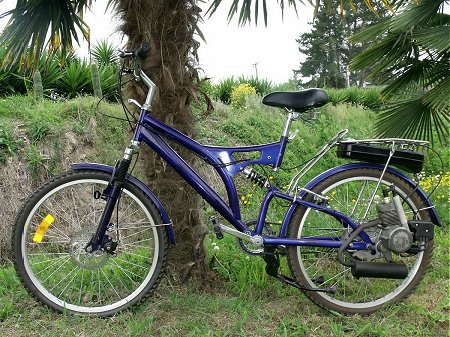
Imported by Motrex, the second batch Morini cyclemotor models came into New Zealand around 2008, now mounted in rear-sprung mountain bike frames but demonstrating exactly the same rear wheel spacing/axle/bearing issues as afflicted the first batch. The frames were also equipped with similar compression sprung forks, fitted the same 24×1.25 tyre & wheel size and same fuel tank carrier arrangement.
Our second batch example is painted metallic blue, though other colours are believed to have been supplied and metallic maroon examples have also been seen.
The axle set of our second example has been re-engineered, so the driving wheel ran smoothly and now demonstrates none of the failing mechanical traits of the first sample. Apart from only achieving a lower best recorded downhill speed of 21mph, our test ride of the blue second batch machine was otherwise pretty similar to the first bike, but without the worry of any potentially catastrophic axle failure.
In what seems like another example of history repeating itself, Motrex belatedly discovered the same quality engineering failings of their batch of machines and didn't involve themselves with the burden of any further imports.
What subsequently happened was that the agents became stuck with quite a few 'dodgy' leftover cyclemotors and ended up unloading these bikes, with all the service engines and parts, as a cheap 'clear-all' job lot to a New Zealand cyclemotor enthusiast group, who produced a re-engineered axle/bearing/spacing arrangement to resolve the technical problems and return the bikes to practical service.
Appreciating the qualities of the Morini motor wheel element, but particularly disliking the characterless attributes of the modern mountain bike cycle frame, was how the Moto-Martin Morini Special came about, being constructed for the first New Zealand Cyclemotor Rally at Clyde near Cromwell in 2008.
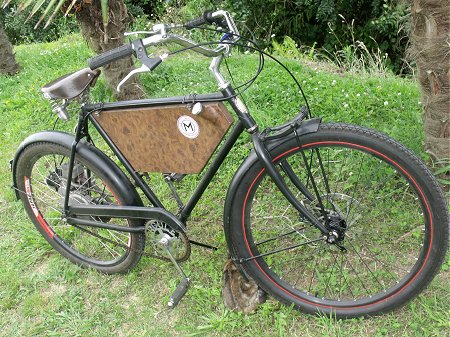
One of the 'first batch' mountain bikes was broken up for a donor motor to build a retro-special based on a 1966 BSA-badged cycle frame, dating as suggested by indication on what were believed to be the original hubs.
This frame was of particular interest because of its established local history; it was bought new by the Tauranga Harbour Board as the 'Watchman's Bike', discarded after many faithful years of service, and finally recovered as little more than a decomposed rolling chassis.
Having been bought out by Raleigh in 1957, by 1966 BSA cycles were technically little more than a badge branded product based upon a Nottingham-made frame.
The chassis was widened out to 145mm to accommodate the motor wheel, by cutting the frame and inserting a small angle iron extension then, to prevent fouling by the pedal arms, needed a 200mm extended crank spindle, which now runs on sealed bearings to replace the adjustable cups.
Replacing the original BSA 37 tooth chain wheel with a Hercules 48 tooth chain wheel allows for more effective rider assistance if required, and the chosen pedals are chunky Phillips block type.
Disc calliper compatible Milzano 'Crazy Horse' forks replaced the original BSA set. Being wider: 110mm between tips, allows installation of a Novatec quick-release, disc-braked front hub, with a calliper mounting brazed to the left leg and the addition of mudguard stay locations from both sides to further support a central mounting from the original calliper hole. The 32-hole front hub is laced into a 26-inch Alex Supera-BH Pro double-wall alloy rim with stainless eyelets for super rigidity. The 36-hole Morini hub is re-laced to a matching 26-inch Alex rim arrangement at the rear, and both ends shod with CST 'general style' 26×2.125 tyres.
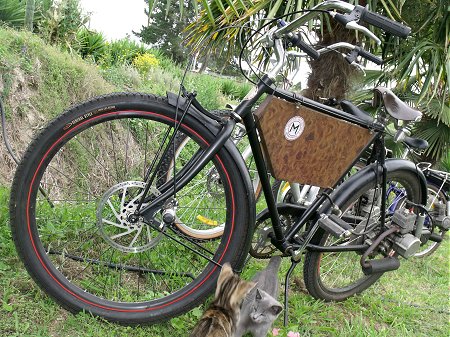
Finished in a simulated wood-effect coating, the slim-line 'frame panel' fuel tank is fabricated from 1.2mm mild steel plate and strip with completely welded construction and no folds.
Handlebars and brake levers are donated from the original silver mountain bike frame, while the nasty plastic throttle trigger is replaced by a nice old Villiers long-lever throttle and it's bound to be much more controllable as a result.
Period sympathetic looking seat is donated from an NSU Quickly moped.
Due to having slightly larger diameter wheels for a higher final drive, our radar gun clocked the M-M at 24mph on the flat, and best of 26mph on downhill run.
The general ride was much improved from the better road tyre tread pattern, but as speed and revs got up you still became aware of resonation and vibration around the general cycle fittings, along with the ever present reduction transmission gear noise.
Rear braking on the Moto-Martin utilises the Morini band brake mechanism, which probably produces more complaining noises than practical stopping ability, but at least looks tidier than any cycle calliper brake.
The M-M was certainly the best of the three bikes we tested. The retro looks generate greater visual interest than the soulless and inferior riding mountain bikes. Its Alex rim arrangement produces a much more structural wheel, to the overall benefit of the general riding impression.
The Morini FM128 cyclemotor engine is particularly eager and enthusiastic within its range, which can offer some useful advantage in brisk acceleration and being relatively un-fazed by hills. There should be few occasions when the rider will be called upon to pedal assist. It's a frantic and angry little engine, and the revs it can easily achieve with resultant vibration can soon be quite wearing if held at speed and only really becomes more practical to ride any distance provided the pace is reasonably regulated. Its general characteristics probably don't make it a pleasant bike to ride, but it is an impressive experience of what can be achieved from a modern interpretation of a small capacity cyclemotor.
We don't know exactly what international markets the Morini cyclemotor was sold into and aren't aware of any formal imports to the UK, but they're probably worth keeping an eye out for as another curiosity.
The FM128 wasn't the only rear wheel cyclemotor Morini Franco produced. It's little appreciated they also manufactured the 30cc Saxonette Type 301/AB for Sachs, sold in Germany in Sachs branded cycle frames, and probably more familiarly in the Netherlands as the Spartamet motor wheel bike.
Later sales of proprietary engines and Moto Morini branded motor cycles were unable to support the business and, after failing to pay suppliers or staff in September 2009, Moto Morini SpA filed submission for bankruptcy protection, with an application for government assistance.
There was hope of re-financing the company as Paolo Berlusconi (brother of Prime Minister Silvio Berlusconi and owner of the Garelli brand) expressed interest in investment, but failed to reach agreement with the labour unions, and withdrew from the venture.
The company continued trading in administration during 2010, with many stock model motor cycles being sold direct to customers at heavily discounted fire-sale prices.
Though the company went into final liquidation in late 2010, some staff were recalled by the liquidator in early 2011 to construct a number more bikes from spare parts stock.
Following the assembly of some 40 to 45 further machines, the company and its intellectual property rights were put up for sale in April 2011 but, despite interest from a number of parties, no deal was completed.
Finally, in July 2011, the rights to Moto Morini and Morini Franco Motori were sold for €1,960,000 to a newly formed company registered as Eagle Bike, and founded by two Italian entrepreneurs, Sandro Capotosti and Ruggeromassimo Jannuzelli.
The Morini factories were not included in the sale, though Eagle Bike did manage to secure a 2-year lease on use of the premises and remaining equipment. Production resumed in March 2012 with a Giubileo limited edition version of Rebello 1200, while Corsaro Veloce and Scrambler models are planned to follow.
It seems the Morini story has opened another new chapter...
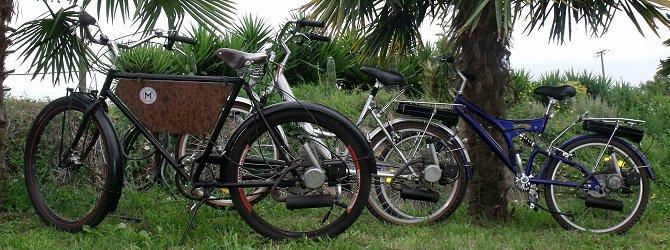
Next - A combination of global warming and the seasonal summer melt in the Midlands tundra region finds an age-old chunk of ice cracking from the Bimingham Greet Glacier, then floating as a berg down the Grand Union Canal.
Frozen inside, some ancient prehistoric machine, now long extinct - coming soon, "Return of the Mammoth"!
This article appeared in the July 2012 Iceni CAM
Magazine.
[Text and photos © 2012
M Daniels.]
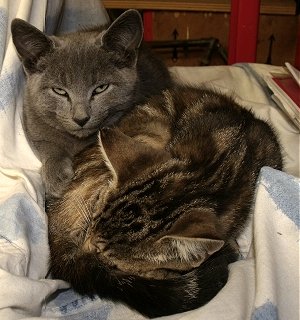
After the Gold Rush was one of the NZ spin-off articles produced as a sideshow to the People Power main event.
The Morini Fm128 cyclemotors were other particularly interesting machines in the Kelven Martin collection, and a motor model that didn't find its way to UK shores, so it became a case of "While you're over at Pongakawa, could you maybe look at the Morini as well?"
It was a long and busy day, testing, photographing, and taking notes on a succession of machines that Kelven dragged out. In all, we completed dossiers on six bikes that day, so there are still a couple more NZ features lurking somewhere in the tubes.
Kelven recently adopted a couple of kittens that had taken up residence in the motor cycle warehouse. During the day's activities the kittens took to following us everywhere (as kittens do), frolicking about, playing chase with each other, and particularly popping up in-shot during the photoshoots - which produced several moments of distraction. You might even notice them appearing in some shots if you look carefully.
Kelven kindly lent all the Morini Fm128 and Honda People cyclemotor specifications for scanning into the library files, so anyone wanting further technical details can source this material from the IceniCAM Information Service.
Quite significant progress had been made in further research and drafting up the notes to a developed text file even before IceniCAM edition 21 went out on 15th April 2012, so After the Gold Rush was looking pretty secure for the next edition before becoming file completion number five at Agios Georgios in Cyprus during May - all well ahead of schedule, very strange!
Article sponsorship was credited to Colin Clover, Suffolk Section EACC. Not for any particular reason other than his credit came to the top of the 'non-specific feature' list and just got tagged to Gold Rush. There's no pretence that the donation in any way even remotely contributed towards the production cost of flying to New Zealand to test the Morini's on North Island, but we've got to keep attaching even random sponsorship credits to features or we'll never keep up with them.